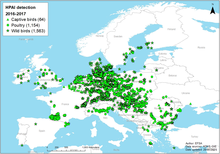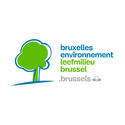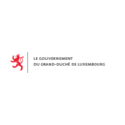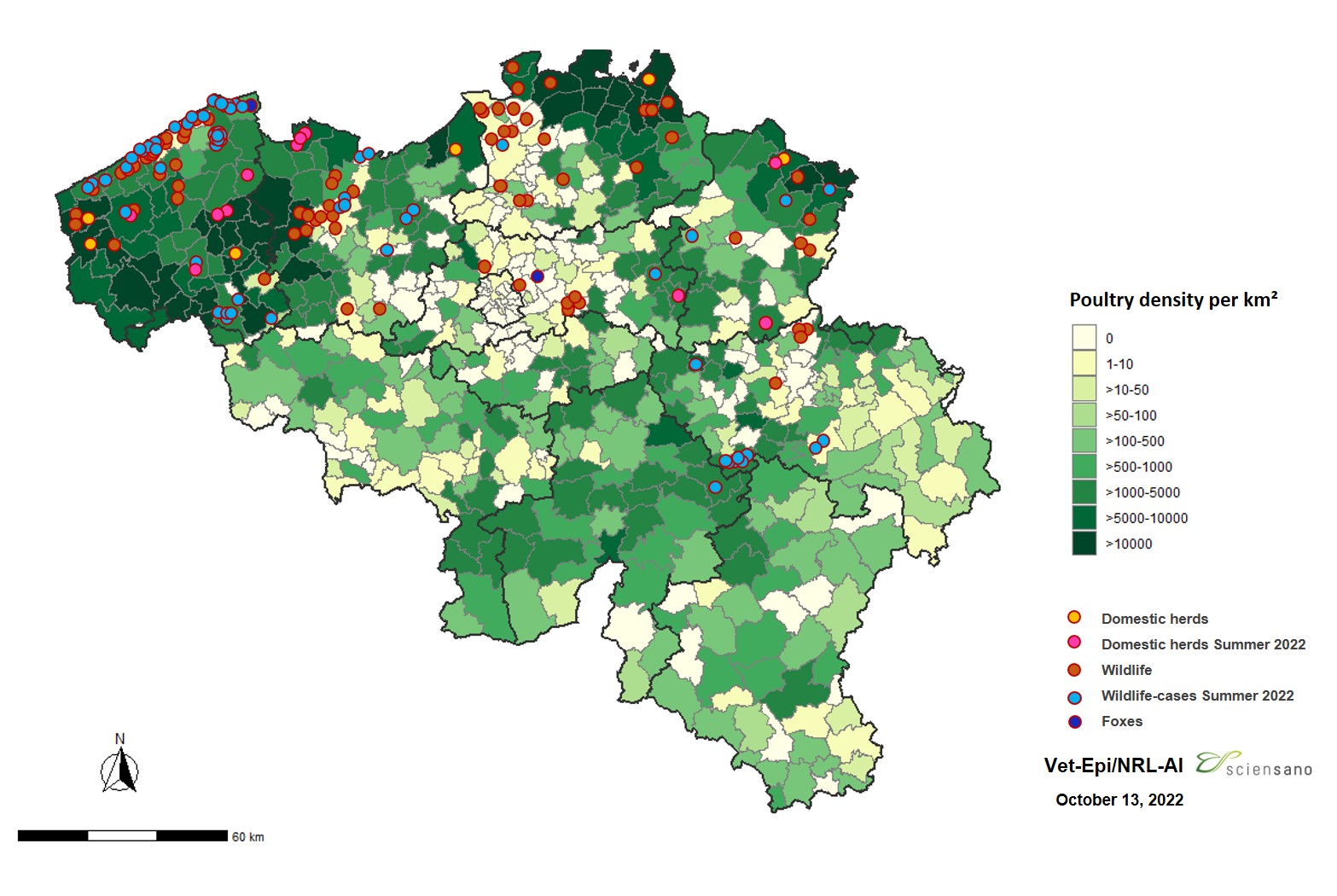In short
Bird flu (also known as fowl pest or Avian Influenza) is a viral disease that occurs in poultry. The most severe (highly pathogenic) form is extremely infectious, and can have considerable consequences for the poultry industry. Rapid diagnosis of this disease is therefore very important. The national reference laboratory for Avian Influenza therefore constantly screens the bird population in our country via a number of monitoring programs.
Project description
Avian Influenza occurs in poultry in two forms: a mild (low pathogenic) or severe (highly pathogenic) form, referring to the severity of the clinical symptoms. The low pathogenic variant produces mild symptoms such as breathing problems, decreased egg production and limited mortality. With the highly pathogenic variant, (sudden) death can be up to 100%. The most striking symptoms are blue marks on the comb/wattle and neurological symptoms such as trembling, running round in circles or loss of balance.
The highly pathogenic form of the H5 or H7 subtype is extremely infectious and can have considerable economic and social consequences. Outbreaks of highly pathogenic bird flu are notifiable diseases that must be reported to the EU, and the businesses concerned are subject to compulsory clearance.
The national reference laboratory for Avian Influenza conducts compulsory monitoring programs in the poultry industry, on birds living in captivity and on birds living in the wild. In the poultry industry, we therefore conduct serological tests on a routine basis, with clinical monitoring also carried out to detect the presence of the virus promptly. As part of clinical monitoring, samples are taken when certain criteria (Numac 2008024199) are met on a farm in order to rule out the presence of Avian Influenza. If there is an acute suspicion of bird flu, the farm contacts the crisis unit at the Belgian Federal Agency for the Safety of the Food Chain (FAVV/FASFC), after which the national reference laboratory conducts an urgent test to establish the diagnosis. Both the rule-out diagnosis and the emergency diagnosis are legally required analyses that are free for the poultry farmer.
With regard to wild birds and certain mammals, we conduct continuous monitoring of the presence of Avian Influenza in nature in collaboration with the regions, (Agentschap Natuur en Bos [Nature and Woodland Agency], Leefmilieu Brussel [Brussels Environment] and the ‘Département nature et forêt’ [Nature and Forestry Department]).
Results
Outbreaks of bird flu in Europe
Since 2014, the highly pathogenic form of the bird flu virus (highly pathogenic H5Nx-influenza strains) has occurred regularly in Europe. Since 2016, this has been the “clade 2.3.4.4b H5” strain.
|
Season |
Number of outbreaks in Europe |
|---|---|
|
2016-2017 |
2,781 |
|
2017-2018 |
166 |
|
2018-2019 |
21 |
|
2019-2020 |
334 |
|
2020-2021 |
3,559 |
| 2016-2017 | 2017-2018 |
 |
 |
| 2018-2019 | 2019-2020 |
 |
 |
| 2020-2021 | |
 |
Figure 1: Representation of the outbreaks in the various clade 2.3.4.4b HPAI-H5 seasons since 2016 (source: EFSA). Circle = outbreak in poultry, star = outbreak in wild birds, triangle = outbreak in birds living in captivity.
The type of virus currently circulating is especially virulent for both poultry and birds living in the wild. The European Food Safety Authority (EFSA) has labeled the bird flu outbreak of the winter of 2020-2021 the most devastating and long-lasting epidemic of highly pathogenic avian influenza (HPAI) that has ever occurred in Europe.
Bird Flu in Belgium
Only two outbreaks of HPH5Nx were observed in 2020 whereas, in 2021, the Belgian NRL for Avian Influenza confirmed 11 outbreaks on farms (6) and in animals living in captivity, and all of this without any real interruption over the summer period. A remarkable development because, up to then, the outbreaks of the influenza virus occurred primarily in the winter period and there was a characteristic “summer break”. The loss of seasonality could indicate persistent circulation of the virus in animals living in the wild.
The autumn migration of wild birds in 2021 breathed new life into the epidemic, bringing with it a stream of new highly pathogenic H5Nx-viruses. The first positive wild bird of the new wave in Belgium was confirmed on 12 November 2021, and was followed by the first positive poultry business on 8 December 2021. The 2021-2022 bird-flu season was testament to the usefulness of the surveillance of wild birds as a warning system.
In 2021, at total of 30 wild birds, such as geese, ducks, birds of prey and coastal birds, tested positive for the highly-pathogenic H5Nx-strain of the virus. Within one month (January 2022), there were an additional 30 new detections in wild birds, meaning there was a lot of (highly-pathogenic H5) bird-flu virus circulating among these animals (high infection levels) at the time. These cases in wild birds were primarily detected in the north of our country, which is particularly densely populated with water birds, but which is also where the vast majority of our poultry businesses are located. The first wild bird to test positive in Wallonia was reported on 9 February 2021 in the province of Liège.
The circulation of the virus in wild birds continued in high number during spring and into summer. During summer high number of shore birds (‘Laridae’-family) became infected. A selection of birds found dead are send in for diagnostic testing at Sciensano. From January until the end of July 74 wild birds were found infected, while 0 cases were confirmed in May, 33 of them were confirmed throughout June and July.
Figure 2: Overview of the highly-pathogenic H5N1 detections in Belgium in wild birds (orange-light blue), the poultry sector (yellow-pink) and red foxes (blue), combined with the poultry density in the different municipalities. The autumn-winter and spring-summer waves are indicated in separate colors.
Despite the large number of wild birds that test positive for highly-pathogenic bird flu and the high infection levels in nature, the number of infections in the poultry sector remains limited (7 in total for the 2021-2022 season, with 4 in 2022) and there are no secondary infections in areas with a lot of poultry businesses. That demonstrates the high vigilance that this sector has implemented to avoid introductions of the virus in their sheds. This also confirms the usefulness of the measures that apply in the event of increased vigilance and an outbreak in a business.
Genetic research and analyses
In 2021, the NRL extended its scientific expertise on highly-pathogenic bird flu viruses even further. Numerous circulating H5Nx virus strains were isolated, after which the properties of their genetic material, their origin (phylogenetic characteristics) and the extent to which they make birds sick (pathogenicity) and are contagious were researched. As a result, the international community currently has free use of the full genome sequence of 30 Belgian HP-H5 strains.
Working with the other actors involved in this bird-flu epidemic, such as the Federal Agency for the Safety of the Food Chain, the regional laboratories and the regions (ANB [Nature and Woodland Agency], DNF [Nature and Forestry Department] and LB [Brussels Environment]), the NRL conducted 35% more analyses in 2021 than in the previous year.
Risk of infection of mammals
In Europe (United Kingdom, the Netherlands, Sweden, Finland and Estonia) between January 2020 and January 2022, ten infections with highly-pathogenic bird flu (H5) were confirmed in wild mammals, primarily in foxes (Vulpes vulpes). Consequently, working with the 3 regions in Belgium, monitoring is being set up for wild mammals that feed on the cadavers of wild birds.
Within this framework, the NRL is also researching the full genome sequences for the presence of genetic elements that could indicate further transmission of the virus to mammals, and therefore also to people (zoonotic markers indicative of adaptation). Up to now (situation at the beginning of February 2022), the European and World Health Agency consider the risk of a wider infection of the human population as “low”. However, the professional risk for people who come into contact with birds is elevated to “medium” and therefore requires increased vigilance. Within this context, Sciensano is converting the current symptom-based system for detecting infections to a proactive system for everyone who comes into close contact with birds that are bred, kept in captivity or live in the wild.
In 2022 two red foxes were found positive in Belgium: one at the coast and one more central of country. They most likely became infected by scavenging on infected wild birds.
In parallel with this initiative, we are looking for ways to evaluate the zoonotic potential of the strains circulating in Belgium using in vitro alternatives, though without conducting experiments on ferrets.
The public are asked to observe the minimum hygiene and protective measures when handling sick or dead birds and mammals that may feed on infected wild-bird cadavers.
Sciensano's project investigator(s):
Service(s) working on this project
Partners















